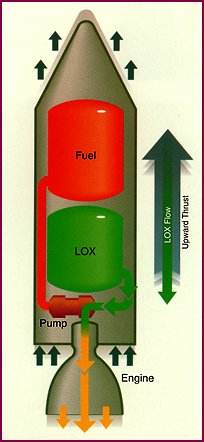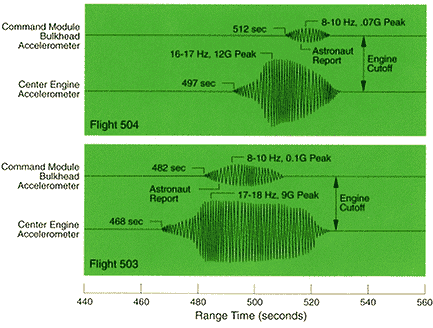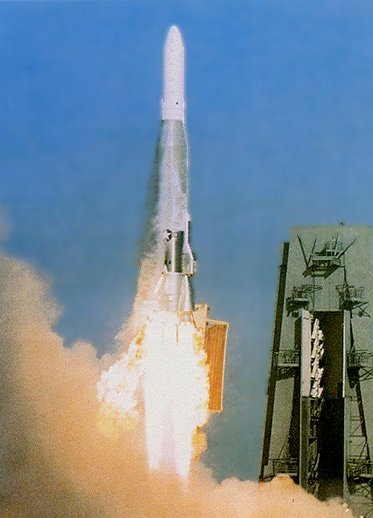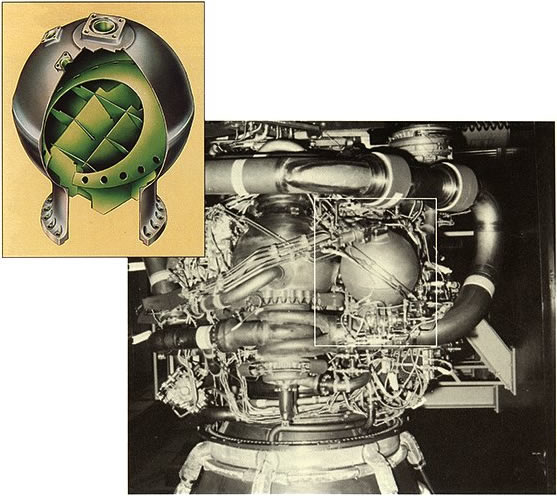
Astronaut Frank Borman, commander of Apollo 8, rides the centrifuge at Manned Space Cetner, Houston, Texes. Special instrumentation was added to simulate pogo effects that might be encountered during actual flight. Photo courtesy of NASA. |
It first showed up in early unmanned flights of the Titan-Gemini: a low frequency vibration of the entire vehicle that observers likened to the motion of a child bouncing on a pogo stick. And it was decidedly not good, this strange phenomenon that was quickly recognized as a dangerous threat to the whole endeavor of manned rocket flight. There is even some evidence that the phenomenon occurred on the ground in the early 1950s during static firings of the Redstone rocket engine.
The problem involved the vehicle structure, the column of propellant in the feed fine to the engine, and the engine itself.
As the engine moves upward, pressure at the turbopump propellant inlet increases, producing a force that acts upward on the propellant and downward on the engine and structure. This increased pressure causes additional flow into the engine that is burned in the main thrust chamber, and in turn, produces an additional upward force on the vehicle structure. Thus, if the upward force from the engine is greater than the downward force at the engine fuel inlet, the engine acts like negative structural damping with potential for pogo. To result in instability or divergent oscillation may also require frequency matching or tuning of the feed system resonance with a structural resonance. Since tuning and detuning occur naturally during a flight as the propellant in the tanks is consumed, the phenomenon itself could be transient.
The Jupiter vehicle of the late 1950s, though not afflicted with true pogo, endured stability trials of its own. The phenomenon became a "red herring" that confused recognition and solution of the real problem when it occurred later on Thor. But the Jupiter problems did initiate an interest in the bulk dynamics of fluid cavitation, a related and critical phenomenon that had not yet been fully appreciated.
Jupiter was a vehicle made by Chrysler and powered by a 150,000-pound-thrust Pratt & Whitney Rocketdyne (now Rocketdyne Propulsion and Power, a part of The Pratt & Whitney Company) LOX/RP (liquid oxygen/kerosene) engine. During a missile static test at the Army Ballistic Missile Agency (ABMA) in September 1958, pressure oscillations of 20 Hz were seen in the liquid oxygen pump inlet to the engine. Yet in subsequent testing at Boeing's Santa Susana Field Laboratory, engineers could not reproduce the oscillations, and it was concluded that the ABMA vibrations were the result of a unique duct geometry and an abnormally low pressure that would not occur in flight.
So in December 1958, a Jupiter missile was launched. During that flight the vehicle experienced a period of 23-Hz oscillations that saturated the servo-operated thrust control system, allowed the engine to operate at the wrong thrust, and gave the guidance system fits. Similar results were obtained on a flight in January 1959, and still it was assumed that the problem was due to the thrust control system, but neither analysis nor testing could verify it.
Testing was renewed on the engine stand and at four pump facilities in an attempt to produce the. oscillations. Finally, 15-Hz oscillations were seen in a LOX pump inlet during tests on a component stand. Although the range of inlet pressures that was tried was very narrow, there was no doubt that the pump caused oscillation.
At the pump inlet was a short inducer section that gave the fluid an initial spin so that it would enter the main pumping section (impeller) smoothly without cavitation-the formation of unwanted bubbles. Generally, bubbles were expected to form on the inducer, but should then collapse before entering the impeller. It was obvious that the dynamics of the cavitating inducer were involved in the oscillations.

The pogo phenomenon: as the engine moves upward cyclically, propellant fluid is forced into the turbopump. This excess fluid is converted into unwanted thrust which tends to move the engine even farther. The net result could be felt in the spacecraft or, worse, could lead to structural failure in the booster. |
Many variations were made to change the cavitation effects caused by the inducer. Leading edges of the inducer were modified, the blade lead angle was changed, tip clearance was increased, and both three- and four-blade versions were tested. Although the inlet pressures resulting in the oscillation and its frequency changed somewhat, the only sure way to eliminate the oscillations was to remove the inducer - which made the pump performance inadequate for flight. Finally, the oscillations were eliminated by drilling half-inch holes in the leading edge of the four inducer blades. The "holey inducer," as it was called, proved successful in flight in May of 1959 and was used in dozens of flights with no indication of oscillations.
While the Jupiter oscillations were not pogo, they were the first hint of the importance of inlet pressure and cavitation on tuning feed line resonant frequencies in the vehicle problems that would follow.
The Jupiter and Thor vehicles were developed in the same time frame, using similar rocket engines and turbopumps. Initial flights of the Thor vehicle were with light payloads, high axial acceleration and high inlet pressures. There was some low frequency vibration, but it tended to be rather random like a hard-sprung car driving slowly down a gravel road.
Later flights used an uprated (165,000-pound thrust) engine with a higher performance LOX pump inducer. The vehicle was heavier, so it flew with reduced axial acceleration and lower pump inlet pressures. Many flights showed sustained accordion-like oscillations beginning about 10 seconds prior to engine cutoff at a frequency of 20 Hz. The engine end of the vehicle shook twice as hard as the front end; with a typical 4-G motion, the stroke-or up and-down motion-at the engine was 0.1 inch, with 10 psi oscillations at the LOX pump inlet and 30 psi at the fuel pump. The large oscillations at the fuel pump were puzzling and were assumed to be caused by some type of coupling through the vehicle structure. Lockheed's Agena was the payload and was strong enough to take the loads, so no "quick fix" was required. Nevertheless, a program decision was made to add instrumentation and learn as much as possible about the problem by using flight data and analysis of the vehicle and engine. In addition, a test program was initiated to develop a hole pattern in the inducer along the lines of the Jupiter.
The parallel system-analysis/pump-modification program was initiated in April 1961, completed in August 1961, and included inducer modifications, testing in a water tunnel, and 13 full engine tests using the standard and modified hardware. The high-performance Thor inducer had oscillations very similar to the Jupiter and a similar hole pattern eliminated them. But low amplitude "noise" could still be seen in strip charts of engine inlet pressure and the frequency was found to be a consistent function of inlet net positive suction pressure (NPSP), a cavitation parameter.
The system analysis came to a surprising conclusion. The Thor oscillations could not be attributed to the pump, so it was decided that flying a "holey inducer" should have very little effect on the oscillations. The real problem was an instability that was produced when the inlet lines "tuned" with the structure. The recommendation was to put a small accumulator just upstream of the fuel pump to prevent tuning, or at least force earlier tuning in such a way that the vehicle could not respond with such high amplitude.
The "holey inducer" was flown and did not change the vehicle vibration, apparently verifying the new theory. But the use of a fuel system accumulator for the Thor was not pursued since the attendant loads could be tolerated. Rather, the real value of this early work was to support the Titan-Gemini program.
Around 1970, Thor-Delta vehicle changes to accommodate greater payloads led to several periods of vibration, with end-of-flight oscillation still the most violent. A pogo suppresser, based on the design used successfully on the Saturn SII stage, was installed at the LOX pump inlet duct, alleviating the problem.
In the early 1990s, another major engine-vehicle uprating was accomplished. The SII-derived pogo suppresser was maintained and the LOX tank pressure increased; pogo oscillation continued to exist, but remained at acceptably low levels.
Initial flights of the Titan II vehicle took place in early 1962. Flight data showed vibration levels as high as 5 Gs in the 9- to 13-Hz range. Previous studies indicated that vibration at 2 Gs would be very painful for a human and that 1/2 G was the maximum that should be allowed. Hence, the program to launch a two-man Gemini capsule was jeopardized.
The Air Force recognized that the Thor vibration studies might be applicable as modifications, and were devised to combat the problem in Titan II. The first innovation was to add a standpipe and a tee in the oxidizer propellant feed system just upstream of the oxidizer pump. The pipe stood vertically and was partially filled with gaseous nitrogen. The idea was to tune the standpipe with a gaseous nitrogen bubble to absorb flow oscillations in the 11-Hz frequency range. This modification was flown, but it actually increased the violence of the vibration so much that a guidance accelerometer triggered premature engine cutoff for the stage.
At the same time, vibration tests for astronauts were conducted by NASA at the Ames Research Center. The tests were performed on a centrifuge with superimposed 11-Hz vibration and confirmed human discomfort limits previously established. Pain was directly associated with motion of the eyeballs and testicles, as well as from internal heating that resulted from sloshing of the brain and viscera. The vibration frequency was also in the range of normal brain waves, adding confusion to decision making, hand and arm movement, and even speech.
 Data recorded from on-board accelerometers on the first two Saturn manned flights showed pogo as measured at the source, specifically, the center engine mount and the response at the crew module.
Data recorded from on-board accelerometers on the first two Saturn manned flights showed pogo as measured at the source, specifically, the center engine mount and the response at the crew module. |
Extensive testing was also done to generate test-verified equations describing the dynamics of structure, the propellant feed systems and the engines. Pump tests showed that as inlet pressures were reduced toward cavitation, the pump started acting as an amplifier, causing large oscillations in the thrust chamber pressure.
By late 1963, studies were complete. The fuel pump had been modified slightly, and a piston accumulator had been built for the fuel system and added to the vehicle. The system was flown with suppression devices on both the fuel and oxidizer feed lines with unqualified success.
An interesting note involves the standpipe. Normally the standpipe was charged with nitrogen shortly before liftoff. On one flight, however, there was a hold after the gas was inserted. The oxidizer on that vehicle was nitrogen tetroxide which dissolves nitrogen gas.
At launch, part of the gas had already been absorbed and the nitrogen bubble was smaller than desired so that the standpipe frequency was too high to do a good job of absorbing the 11-Hz vibrations. For that launch, the oscillations peaked at nearly 0.8 Gs (peak-to-peak). The astronauts reported difficulty in reading instruments and their speech was impaired.
The Atlas is unique as a vehicle, built like a huge stainless steel balloon, rather than with conventional ribs and stringers. It apparently gave a soft ride to its passengers, but it too had its share of pogo.
Early Atlas launches showed 5- to 6-Hz vibrations during the first 20 seconds after liftoff that grew to several Gs at the engine before subsiding. Analyses and component testing showed that it was a new phenomenon, subsequently named gas-pogo or bloating.

The balloon-like stainless steel Atlas vehicle provided a soft ride for its passengers, but it, too, had its share of pogo. |
In normal procedures the upper (oxidizer) tank was given a quick shot of pressurizing gas just after liftoff when the tank was almost completely filled with liquid. The tank would swell slightly and extend axially like a balloon. The axial frequency of the vehicle was about 5 Hz at liftoff. Since the tank pressure regulator was at the aft of the big vehicle and near the supply of warm helium, the gas pressure sensing line had to run the entire length of the vehicle. The 'organ pipe' frequency for this long pressure sensing line also turned out to be about 5 Hz. This tuning continued to excite the structure until enough liquid was pulled out of the tank to detune the structural frequency.
Nevertheless, real pogo did exist on the Atlas, occurring for a few seconds just prior to booster engine cutoff. Typically, the frequency was about 12 Hz, but with an amplitude at the payload that was small enough to easily meet the vibration requirement for manned flight.
In February 1966, the results of a vertical shake test of the full scale Atlas vehicle conducted by NASA Lewis Research Center were presented, along with preliminary results of a similar test of the Thor vehicle at NASA Langley Research Center. An important feature of both structural tests was the evaluation of vehicle structural damping at the various fill levels (simulated in tests with water). Another key feature was the comparison of the results of dynamic tests and analysis of large structures containing fluids. The difficulty of modeling large bulks of fluid interacting with flexible tanks was just beginning to be appreciated.
With the outbreak of pogo on nearly all large launch vehicles, the Saturn V moon mission was of great concern.
Most studies on mathematical models showed that using low structural damping and wide tolerances indicated instability in flight, a universal rule for pogo studies on any vehicle. The solution was to narrow component tolerances by appropriate testing. Pulsing tests were run on the pumps for the F-1 ( first-stage engine) and the J-2 ( second- and third-stage engines) to estimate the fluid softness due to cavitation. However, the complexity of pump cavitation was not yet appreciated, and major interest was focused on the effect of inlet pressure level on the inlet line frequency, while the effect of amplification by the pump was neglected. Testing with an inlet pulser was quite expensive, but pulsers were made for use on the J-2 if needed. While no suppression device was made, it was planned that if a problem was found, it would be corrected by trickling a small amount of helium into the top of the appropriate propellant feed line to reduce the frequency.
The first Saturn V launch, flight AS-501, occurred on November 9,1967, with no hint of a pogo problem. But during the AS-502 launch on April 4,1968, a big "football" was seen on the accelerometer in the first-stage burn. The oscillations occurred at 105-140 seconds after liftoff, at 5 Hz, with an amplitude of 1/3 G at the aft of the vehicle where the five F-1 engines were located. Now that we knew where to look, we found a similar, but smaller, transient on the previous launch, flight AS-501.
On the engine test stands, inlet system pulsing tests were conducted on the F-1 engine. To do this, motion limit stops were pulled out of a J-2 engine valve and adapted with a pulley and V-belt to create a LOX dump system for exciting the propellant feed systems.
The helium trickle concept was evaluated by NASA in a horizontal duct on a centrifuge to simulate the axial pressure gradient experienced in flight. While it changed the frequency, it was such a strong effect that the frequency variation could not be controlled under the acceleration and tank pressure in flight.
In another concept, Pratt & Whitney Rocketdyne converted the annular volume in valve housings located in the LOX ducts for use as gas accumulators to reduce the feed system frequency. Gaseous oxygen was initially tried, but the valves were so cold that the gas immediately condensed. Helium was also tried, but with reservations since it could affect the combustion stability of the main thrust chamber and/or that of the gas generator.
The final scheme was to precharge the valve housings after LOX tanking-but before tank pressurization-and to initiate a very small helium flow at engine start to maintain a bubble throughout flight. And this idea really worked.
On December 21,1968, the first manned Saturn V AS-503 lifted off to demonstrate the capability of the Apollo 8 conunand module to perform the lunar mission. At engine start, some of the helium gas entered the liquid oxygen flow stream and was carried down the line and caused four of the five 1.5-million-pound-thrust F-1 engines to "burp," as gas was expelled through the engines. The center engine, however, never "burped" because studies had shown that helium in the center engine valve housing would lead to another pogo problem at a higher frequency. In concert, all five engines performed beautifully.
But unhappily, with the Saturn V second stage, pogo, like a bad penny, was back.
Near the end of second stage burn, Frank Borman, the command pilot, said he felt a little pogo. Data indicated that 50 seconds prior to second-stage cutoff, the engine in the center of the cluster of five began to vibrate at 18 Hz. Further analysis showed that the crossbeam-mounted center engine and the LOX tank bottom were vibrating like two prongs of a giant tuning fork. Since the outer engines had very little motion, those vibrations were not transmitted up the skin of the vehicle and the crew did not feel them. What they actually felt was small and no real threat, but the 18-Hz vibration was critical and had to be resolved.
One approach suggested that an increase in tank pressure could increase the feed line frequency and detune the system. The risk was that if the oscillations were currently being limited by pump cavitation, then the increased tank pressure could eliminate the cavitation and allow larger amplitudes. An alternate method was to turn the center engine off 75 seconds early and burn the remaining engines longer with some reduced stage performance. The decision was to go with increased pressure, and flight AS-504 proceeded about the same as AS-503; but additional instrumentation showed G-levels too close to structural limits. On subsequent flights, the center engine was cut off early.
 The SSME pogo suppresser is located just upstream of the high-pressure oxidizer turbopump. Flow of gaseous oxygen (GOX) can be routed through the suppresser, where baffles prevent liquid motion that can lead to condensation of the hot GOX bubble that forms at the inlet.
The SSME pogo suppresser is located just upstream of the high-pressure oxidizer turbopump. Flow of gaseous oxygen (GOX) can be routed through the suppresser, where baffles prevent liquid motion that can lead to condensation of the hot GOX bubble that forms at the inlet. |
The next flight, AS-505, was nominal, but the third stage, Douglas' S-IVB (Pratt & Whitney Rocketdyne (now Expendable Launch Systems, a part of The Pratt & Whitney Company), showed a clear pogo oscillation of 20 Hz from 50-100 seconds into the burn of that stage. However, flight history showed that the oscillation was not a generic pogo problem, and the occurrence was never repeated. On flight AS-506, the astronauts complained of high vibration during the second burn of the S-IVB that turned out to be the chattering of a nonpropulsive vent valve system attached to the skin of the vehicle. Douglas changed the tolerance on the valves and that problem was resolved. There was also a small "bulge" of pogo at about 75 seconds into burn on the SII. Flight AS-507 showed four well-defined pogo occurrences during the S-II burn which looked like they might be nonlinearly limited. Decision time had arrived.
Rockwell's Space Division Rocketdyne (now Expendable Launch Systems, a part of The Pratt & Whitney Company) had designed, built, and tested a helium-bleed toroidal pogo suppresser for the oxidizer that we all felt would eliminate the problem. On the other hand, flight AS-508 was ready to go. To install it would require that technicians crawl over cable harnesses to get into the center engine, plus inspection and verification would be difficult. The unanimous vote was to fly AS-508 as is, just like AS-507, and let the built-in nonlinearities do the limiting. We should have known better - this was Apollo 13.
Two early occurrences of second-stage II pogo at 16 Hz were consistent with earlier experience, while a third seemed to be teetering on the edge of acceptability and then just took off. Thrust chamber pressure oscillations in the center engine diverged from a level of 10-500 psi (peak-to-peak) in only 3 seconds. Acceleration reached 68 Gs at the center engine attachment, which translated into 3 inches of stroke. The center engine was shut down by a thrust chamber pressure "OK" switch that sensed low average chamber pressure and initiated shutdown before any detectable failure. The vibration was confined to the center engine of the S-II stage, however, and the outer four engines burned extra long to make up for the center engine's early cutoff. The astronauts continued on, only to have a LOX tank explosion abort their lunar mission.
The suppresser left waiting in the wings was installed for succeeding flights. Other than a little 10.5-Hz buzz in the last few seconds of S-II burn and a small concern about the S-IVB on each flight, pogo was eliminated as a Saturn problem.
For the Space Shuttle, NASA mandated that there would be no pogo. Accordingly, suppressers were designed, and Marshall Space Flight Center provided funding to Caltech for research into pump dynamics. ONERA (the French equivalent of NASA) contributed an ultrasonic flow meter they had developed, and the National Bureau of Standards helped by evaluating and calibrating some required instrumentation.
The Space Shuttle, of course, is unique when compared to its predecessors. Structurally, it lacks axial symmetry, and aerodynamic surfaces have been added. The main engines generate internal pressures three times as high as previous large engines, use a different approach to turbine drive, and use a full closed-loop thrust and a mixture ratio control system that is active into the pogo frequency range. Hence, engine testing required the creation of new approaches, as well as careful re-evaluation of old ones to assure adequate data at tolerable costs, this in order to avoid any potential problem which could incur a remedial cycle in the development process. So for the first time a suppresser was designed as part the engine, here as a broad-band filter, as opposed to a part of the vehicle designed to change the feed line frequency.
The suppression system developed for the shuttle is about the size of a basketball and is teed off the main LOX duct just upstream of the high pressure oxidizer turbopump. While charged with helium at engine start and cutoff, for most of the flight hot (400°F) gaseous oxygen (GOX) is in direct contact with cold (-300°F) LOX. The mixture of GOX and LOX is continuously bled from the suppresser to control the gas volume and thereby the feed system dynamics that prevent pogo. Then the mixture is reintroduced into the feed line upstream of the engine so that all the gas condenses.
The effort has been an outstanding success. There is no pogo on the Space Shuttle, and every effort is being made to keep it that way. Although it is not likely that alternate turbopumps being developed for the shuttle would jeopardize vehicle stability, even this is not being left to chance. NASA decided that they, too, will be tested with the engine for insurance.
There is, in short, little appetite for ever letting the pogo monster out of the box again. |